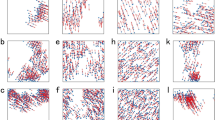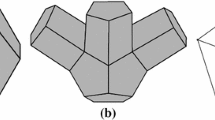Abstract
In this work we develop geometric and numerical methods to analyze the behavior of a system of organisms or particles under various types of pursuit on a regular surface. We consider different types of pursuit similar to some mechanisms proposed by several authors, although treated in a different way. Using different concepts from diverse areas of mathematics, global and time- invariant relationships between the involved particles in the system are characterized. In order to consider different dynamical behaviors depending on individual positions and velocities we applied our geometric pursuit framework defined on regular surfaces to a specific consensus problem.









Similar content being viewed by others
Data availability statement
All data generated or analyzed during this study are included in this published article [and its supplementary information files].
Notes
Locally, system (3) defines a vector field G on TM and its flow is called the geodesic flow on TM where \(t\rightarrow \varphi (t,p,v)\) is the unique trajectory of G which satisfies the initial condition \(\varphi (0,p,v)=(p,v)\).
The diameter D(S) of a surface S is, by definition \(D(S)=\underset{p,q\in S}{\sup } \rho (p,q), \) where \(\rho \) is the intrinsic distance function defined in S.
Couzin et al. identified four dynamical behaviors, one of which is not exhibited in the simulations of our model.
We remind that the model developed by Couzin et al. is in order to investigate the spatial dynamics of animal groups, and they labeled this behavior as swarm in analogy of the motion of insects such as mosquitoes.
References
Aravind, P.K.: A symmetrical pursuit problem on the sphere and the hyperbolic plane. Math. Gaz. 78, 30–36 (1994)
Barton, J.C., Eliezer, C.J.: On pursuit curves. ANZIAM J. 41–3, 358–371 (2000)
Behroozi, F., Gagnon, R.: Cyclic pursuit in a plane. J. Math. Phys. 20, 2212–2216 (1979)
Bernhart, A.: Curves of pursuit. Scr. Math. 20, 125–141 (1954)
Bernhart, A.: Curves of pursuit-II. Scr. Math. 23, 49–65 (1957)
Bernhart, A.: Polygons of pursuit. Scr. Math. 24, 23–50 (1959)
Bernhart, A.: Curves of general pursuit. Scr. Math. 24, 189–206 (1959)
Chung, C.F., Furukawa, T.: A reachability-based strategy for the time-optimal control of autonomous pursuers. Eng. Optim. 40, 67–93 (2008)
Huang, H., Zhang, W., Ding, J., Stipanovic, D.M., Tomlin, C.J.: Guaranteed decentralized pursuit-evasion in the plane with multiple pursuers. CDC-ECE. 4835–4840 (2011)
Klamkin, M.S., Newman, D.J.: Cyclic pursuit or “the three bugs problem”. Am. Math. Mon. 78, 631–639 (1971)
Marshall, J.A., Broucke, M.E., Francis, B.A.: Formations of vehicles in cyclic pursuit. IEEE Trans. Autom. Control 49, 1963–1974 (2004)
Richardson, T.J.: Non-mutual captures in cyclic pursuit. Ann. Math. Artif. Intell. 31, 127–146 (2001)
Sinha, A., Ghose, D.: Generalization of linear cyclic pursuit with application to rendezvous of multiple autonomous agents. IEEE Trans. Autom. Control 51, 1819–1824 (2006)
Awrejcewicz, J., Andrianov, I.V., Manevitch, L.I.: Asymptotic Approaches in Nonlinear Dynamics. New Trends and Applications. Springer, Berlin (2012)
Archibald, R.C., Manning, H.P.: Remarks and historical notes [on the pursuit problem]. Am. Math. Mon. 28, 91–93 (1921)
Ren, W., Beard, R.W., McLain, T.W.: Coordination variables and consensus building in multiple vehicle systems. Coop. Control. 37, 171–188 (2005)
Guibas, L.J., Latombe, J.C., LaValle, S.M., Lin, D., Motwani, R.: A visibility-based pursuit-evasion problem. Int. J. Comput. Geom. Appl. 9, 471–493 (1999)
Ho, Y., Bryson, A., Baron, S.: Differential games and optimal pursuit-evasion strategies. IEEE Trans. Autom. Control 10, 385–389 (1965)
Nahin, P.J.: Chases and Escapes: The Mathematics of Pursuit and Evasion. Princeton University Press, Princeton (2012)
Parsons, T.D.: Pursuit-evasion in a graph. Theory Appl. Gr. 426–441 (1978)
Pereira, T.: Stability of Synchronized Motion in Complex Networks. Lecture Notes, Summer School at. University of Sau Paulo, Brazil (2011)
Schenato, L., Oh, S., Sastry, S., Bose, P.: Swarm coordination for pursuit evasion games using sensor networks. Robotics and Automation. IEEE. 2493–2498 (2005)
Yates, R.C.: Pursuit Curve. A Handbook on Curves and Their Properties. Ann Arbor, MI, pp. 170–171 (1952)
Kamimura, A., Ohira, T.: Group chase and escape. New J. Phys. 12(053013), 1–13 (2010)
Jeanson, R., Dussutour, A., Fourcassié, V.: Key factors for the emergence of collective decision in invertebrates. Front. Neurosci. 6, 1–15 (2012)
Janosov, M., Virágh, C., Vásárhelyi, G., Vicsek, T.: Group chasing tactics: how to catch a faster prey. New J. Phys. 19(053003), 1–16 (2017)
Reynolds, C.W.: Flocks, herds and schools: Dtributed behavioral model. ACM SIGGRAPH Comput. Gr. 21, 25–34 (1987)
Solis, F.J., Yebra, C.: Modeling the pursuit in natural systems: a relaxed oscillation approach. Math. Comput. Model. 52, 956–961 (2010)
Solis, F.J., Yebra, C.: Cyclic pursuit problems in the two dimensional sphere. Appl. Math. Comput. 244, 91–100 (2014)
Do Carmo, M.P.: Riemannian Geometry. Birkhäuser, Boston (1992)
Do Carmo, M.P.: Differential Geometry of Curves and Surfaces. Courier Dover Publications, New York (2016)
O’Neill, B.: Elementary Differential Geometry. Academic Press, New York (1966)
Song, Q., Cao, J., Yu, W.: Second-order leader-following consensus of nonlinear multi-agent systems via pinning control. Syst. Control Lett. 59(9), 553–562 (2010)
Wei, N., Cheng, D.: Leader-following consensus of multi-agent systems under fixed and switching topologies. Syst. Control Lett. 59(3), 209–217 (2010)
Couzin, I.D., Krause, J., James, R., Ruxton, G.D., Franks, N.R.: Collective memory and spatial sorting in animal groups. J. Theor. Biol. 218, 1–11 (2002)
Cziròk, A., Vicsek, M., Vicsek, T.: Collective motion of organisms in three dimensions. Physica A 264, 299–304 (1999)
Cziròk, A., Stanley, H.E., Vicsek, T.: Spontaneously ordered motion of self-propelled particles. J. Phys. A: Math. Gen. 30, 1375–1385 (1997)
Kibangou, A.Y.: Graph Laplacian based matrix design for finite-time distributed average consensus. In: American Control Conference. 1901–1906 (2012)
Acknowledgements
This work was supported by CONACYT Project CB2016-286437
Author information
Authors and Affiliations
Corresponding author
Ethics declarations
Conflict of interest
The authors declare that they have no conflict of interest.
Additional information
Publisher's Note
Springer Nature remains neutral with regard to jurisdictional claims in published maps and institutional affiliations.
This work was supported by CONACyT, Mexico project CB2016-286437.
Rights and permissions
About this article
Cite this article
Solis, F.J., Yebra, C. Pursuit on regular surfaces with application to consensus problems. Nonlinear Dyn 105, 3423–3438 (2021). https://doi.org/10.1007/s11071-021-06800-w
Received:
Accepted:
Published:
Issue Date:
DOI: https://doi.org/10.1007/s11071-021-06800-w




